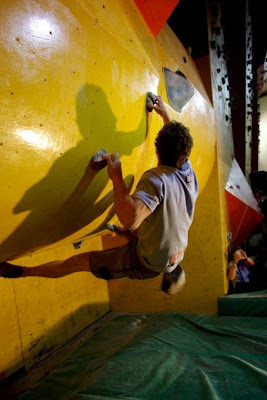One of the scientific articles, published by White & Olsen (2010), analyzed the performance of several elite english bouldering climbers during a national competition. Next chart shows the data obtained.
These numbers give us some guidelines about the effort during this type of competitions. Climbers tried only 3 times each problem (mean), where they spent 30 s to solve each. The work/rest ratio (for 6 minutes period) was 1:4 in each problem. If we consider contact time and time to reach next hold (8 s / 0.6 s) the ratio is 13:1. During route climbing this ratio was 3 s : 1 s (Watts et. al., 2000).
Another interesting thing of this study is that static time is lower than route climbing (25% vs 38 %) founded by Billat et als (1995).
Another study by La Torre et al. (2009) analyzed elite Italian bouldering climbing during two national comps and on simulated comp. In the firsts two comps they analyzed working time and lactate concentration at the end, and in the simulated comp they analyzed times, lactate concentrations at the end of each problem and heart rate during all the competition.
The data presented here differs little from the other study (keep in mind that there is a climbing time of 5 minutes here). Mean of each movement time was lower: 5.3 ± 0.7 s for the national comp and 5.2± 0.6 s for the simulated comp. Mean climbing total time for each problem was 65 ± 20 s and 92 ± 24 s and mean total climbing time for all the comp was 391 ± 85 s and 551 ± 96 s respectively.
Mean heart rate during recovery period did not increase in the simulated comp in males, but slightly increased in females.
Lactate concentrations during simulation didn’t raise with the increase of competition time, but mainly depended on the time needed to climb the attempts of the previous problem. Using regression analysis they determined that changes in lactate concentrations depended on effort duration, with an apparent cut-off value of 20 s. Describing this way short attempts (<20>
In the third study (Michailov et al., 2009), anthropometric characteristics and strength of elite bouldering climbers that participated in a world bouldering cup were measured. Next chart shows their results
Elite bouldering athletes had very low body fat and muscle mass close to 50% in males and 40% in females , same as difficult (routes) climbers.
Male climbers had 20% more grip strength tan route climbers (Watts et al., 2000), this is due to the strength nature of the contest.
Conclusions
The intermittent character of the prove, shows some specific determinants in recovery time during each problem, and during all the event. During a competition (more than 50 minutes) some recovery times are stipulated by rules, and other depends on the climbers tactics and strategies and their recovery capacity. The higher the level of the climber and the more experience has, without doubts the climber will give less attempts, administer better the effort, and therefore his recovery times will be higher.
Using specific training means to increase recovery capacity is a must. Intermittent training (aka interbloque) is an excellent choice to increase it. And due to some problems duration (more than 20 s), lactate accumulation must be removed rapidly, so high intensity interval training can be used to increase lactate removal capacity.
With regard to the action time of the muscles (holds contact time), training should be specific to maintain very high intensity intermittent efforts of 5 to 8 seconds approximately with an excessively short rest (<1>
Strength levels for this type of efforts are very high (20 % plus than route climbing), therefore the strength capacity is also another training goal. The climbers must use specific exercises like hangboard training, system training, campus training and especially boulder climbing, which is the specific exercise.
A high percentage of mass muscular derived from the unspecific strength training can be counter-productive, since the climber will have to move his overweight. That’s why any increase of the muscular mass must be specific and necessary to the demands of the event. It is necessary to control it by periodic anthropometric tests. Therefore the muscular mass should be ideal and the hypertrophy should happen only in the determinant musculature of the performance.
References
1 – White, DJ and Olsen, PD. A time motion analysis of bouldering style competitive rock climbing. J Strength Cond Res 24: 1533-4287, 2010
2 – Billat, V, Palleja, P, Charlaix, T, Rizzardo, P and Janel, N. Energy specificity of rock climbing and aerobic capacity in competitive sport rock climbers. J Sports Med Phys Fitness. 35: 20-24, 1995
3 - Watts, PB, Newburry, V and Sulentic, J. Acute changes in handgrip strength, endurance, and blood actate with sustained sport rock climbing. J Sports Med Phys Fitness. 36: 255-260, 2000
4 - La Torre, A, Crespi, D, Serpiello, FR and Merati,G. Heart rate and blood lactate evaluation in bouldering elite athletes. J Sports Med Phys Fitness. 49: 19-24, 2009
6 – Michailov, ML, Mladenov, LV and Schoffl, VR. Anthropometric and strength characteristics of world-class boulderers. Med Sport. 13(4): 213-238, 2009


















